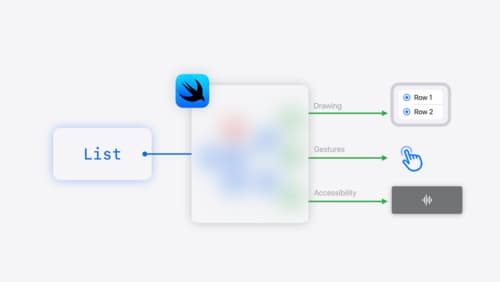How can I build responsive layouts in iOS?
Asked on 2024-07-30
1 search
To build responsive layouts in iOS, you can leverage several techniques and tools discussed in various WWDC sessions:
-
Dynamic Type:
- SwiftUI: Use the
dynamicTypeSizeenvironment keypath to adjust your layout based on the text size. For example, you can switch betweenHStackandVStacklayouts depending on the text size to ensure readability and avoid truncation. This is demonstrated in the session Get started with Dynamic Type. - UIKit: Utilize
UIStackViewto manage your subviews either vertically or horizontally. You can respond to changes in text size by subscribing to theUIContentSizeCategoryDidChangeNotificationand updating the stack view accordingly. More details can be found in the session Get started with Dynamic Type.
- SwiftUI: Use the
-
Safe Areas:
- When designing for different devices, consider the safe areas to avoid overlapping with hardware or software features like rounded corners, the home indicator, or the dynamic island on iPhone. This is particularly important for full-screen experiences on iPad, iPhone, and Mac. This concept is covered in the session Design advanced games for Apple platforms.
-
Adaptive Layouts:
- Break your UI into separate sections anchored to specific sides of the screen. This helps maintain consistent sizes and distances as you move between different device shapes and aspect ratios. This method ensures that your UI remains comfortable and usable across various devices. More on this can be found in the session Design advanced games for Apple platforms.
-
SwiftUI Previews:
- Use Xcode previews to quickly see how your views look in different contexts, including dark mode, accessibility settings, and localization. This helps you understand how your feature will feel as you build it. This is highlighted in the session SwiftUI essentials.
Relevant Sessions:
By following these guidelines and utilizing the tools provided by Apple, you can create responsive and adaptive layouts that provide a great user experience across all iOS devices.

What’s new in AppKit
Discover the latest advances in Mac app development. Get an overview of the new features in macOS Sequoia, and how to adopt them in your app. Explore new ways to integrate your existing code with SwiftUI. Learn about the improvements made to numerous AppKit controls, like toolbars, menus, text input, and more.

Design advanced games for Apple platforms
Learn how to adapt your high-end game so it feels at home on Mac, iPad, and iPhone. We’ll go over how to make your game look stunning on different displays, tailor your input and controls to be intuitive on each device, and take advantage of Apple technologies that deliver great player experiences.

SwiftUI essentials
Join us on a tour of SwiftUI, Apple’s declarative user interface framework. Learn essential concepts for building apps in SwiftUI, like views, state variables, and layout. Discover the breadth of APIs for building fully featured experiences and crafting unique custom components. Whether you’re brand new to SwiftUI or an experienced developer, you’ll learn how to take advantage of what SwiftUI has to offer when building great apps.
